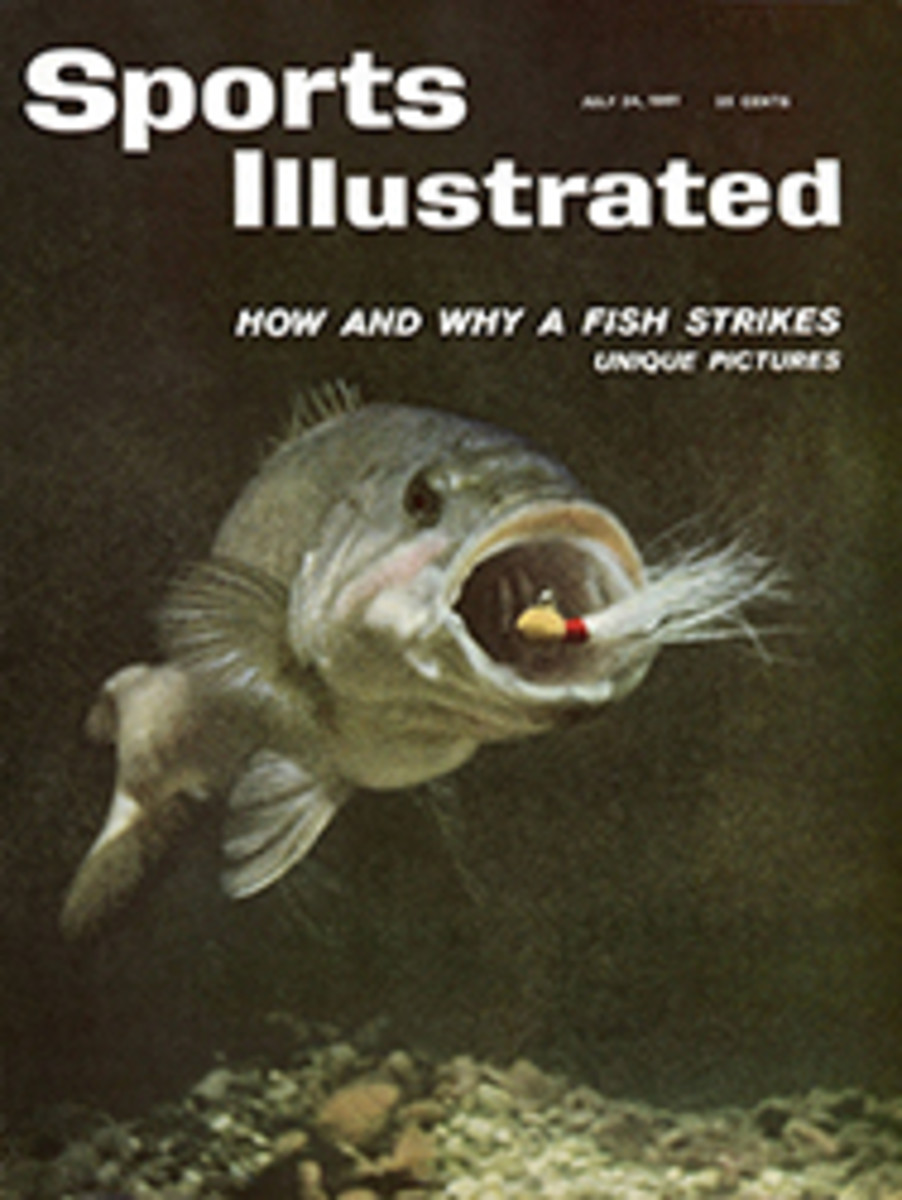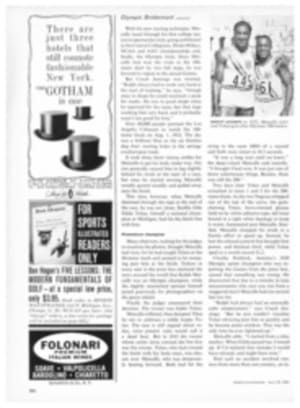
The Pirates' mystery man
With the season one half over, the World Champion Pittsburgh Pirates are in a sad way: they are 9½ games behind, and they show no signs of improving their position. More than anything else, their plight results from the ineffectiveness of Pitcher Vernon Law, who last year won 20 games. This year, plagued by a sore shoulder, he has won only three. "There's nothing wrong with us," says teammate Don Hoak, "that a good Vernon Law won't cure."
Ironically enough, the Pirates are concealing a man who—had he been permitted—might have been able to exercise preventive maintenance on Law, just as he has on other Pirate players. It takes some detective work to find out about him: some players say they're sorry, they'd like to talk—but they can't. Shortstop Dick Groat, the league's Most Valuable Player, is perfectly frank about not being frank. "I'd like to be cooperative," he says, "but the general manager would give me hell if I talked." Others play dumb: "Who? What's his name again? How do you spell it?" And Joe Brown, the Pirate general manager, says unequivocally: "We think the fellow gives us an edge. Why should we let the other teams know about him?"
This mystery man's name is Jay Bender, and he is a research-minded professor of physical education at Southern Illinois University. Bender has developed—by means of a special testing machine—a system of correcting individual muscle weaknesses in the legs and back, thus heading off the danger of possible—and possibly prolonged—injury. In 1960, at the request of the Pittsburgh organization, Bender began to establish his program among the Pirate players. At season's end, the Pittsburgh management secretly credited him with helping the team win its first World Championship in 35 years. (In 1959, when the Pirates did not have Bender's services, disabled players were everywhere, and the team finished a dismal fourth.)
Despite this record, however, Bender is not allowed near pitchers' arms, for the Pirates—like all baseball teams—view these members with superstitious awe. If he were, it is conceivable that Vernon Law would not be on the disabled list. (Lanky Joe Gibbon, troubled with a back injury last year, made a remarkable off-season recovery after spending three weeks at Southern Illinois, though he stoutly refuses to admit that Bender had anything to do with it.) "Pitchers just come down with these ailments," says the team physician fatalistically. "In Vern's case the trouble is deep in the shoulder joint. The rotator muscle, the triceps insertions, the teres major and minor insertions-they all give him pain when he throws. Rest is the only treatment." Physicians not infected with the baseball mystique see a certain flaw in this reasoning. "If the man's allowed to work on the rest of the body," says a dissident, "why not let him condition arms?"
Bender himself stays out of such arguments. A crew-cut man of 47 who looks 10 years younger, he has a scientist's distrust of quick judgment. "Last year may have been luck," he says. "This year will give us a better idea how good the program really is."
Though Bender will not discuss his work with the Pirates specifically—in deference to Brown's wishes—he will outline it in general terms. "When a muscle isn't used," he explains, "it atrophies. During the off season, an athlete's muscles may lose strength, and when he starts playing again he's likely to suffer strains or sprains in these areas. Further, once a player does suffer a muscle or joint injury, he's likely to injure the same area again."
Muscles, Bender points out, may even atrophy in midseason. "Baseball is a somewhat sedentary game," he says with a grin. "A man may not have to run the bases hard for a couple of weeks. Then he tries to dash from first to third on the hit-and-run, and he ends up with a pulled hamstring muscle in his leg."
To forestall such unhappy situations, Bender devised a machine that measures the level of strength in the individual muscles of the legs and back. The machine has pulleys, weights and scales, and it notes the number of pounds of pressure a man is able to exert. If a muscle in one leg, for instance, is noticeably weaker than the corresponding muscle in the other leg, Bender holds that the athlete is liable to injury in the weaker area. The team physician is informed, and the proper remedial exercises are promptly administered. "The beauty of the system," explains Bender, "is that, by pinpointing the weak-muscle areas, we substantially reduce the time needed to strengthen them."
Bender's greatest success so far has been Gene Baker. The former Pirate utility man, now a minor league manager, twisted his knee so badly in 1958 that he pulled the quadriceps tendon out of the bone. "I never thought I'd play again," Baker says soberly. In early 1960 he visited Bender at Southern Illinois and stayed there a month. Once Bender found—on the testing machine—which muscles needed strengthening, he was able to begin the work of rehabilitation. At first the exercises took several hours a day. "I'd sit on a table," says Baker, "and someone would hold my ankles. Then I'd push or pull as hard as I could." Today, insists Baker, his knee is as sound as ever, and he exercises "just a few minutes every other day." Nonetheless, there is irony in the situation. Bender's program was so effective in keeping the varsity players healthy that substitute Baker could not get into the lineup.
Abdominal breathing
Bender has been pursuing the mysteries of the muscle for the past two decades. Along the way he studied under Professor Peter Karpovich of Springfield, the late Charles McCloy of Iowa and Thomas Cureton of Illinois. In the early 1950s he began field tests for his theories with an adult physical fitness program in Peoria, Ill. "The people in it," he says, "were mostly businessmen. They didn't have time for extensive exercise. We gave them simple drills." A favorite such exercise is abdominal breathing, whereby the stomach is pushed out hard with each inhalation. "Salesmen can do it while driving their cars," says Bender. "When done properly it takes a couple of inches off the waistline within a month."
The basis of the exercise system, says Bender, are those exercises (like abdominal breathing) that consist of isometric contractions (i.e., those in which there is internal pushing or pulling but no general body movement). Ordinary exercises consist of isotonic contractions (those in which there is movement). "It's not that we recommend isometric contractions to the exclusion of the others," he explains. "It's just that they're the most convenient." The isometric contractions are made by pushing or pulling the individual muscle for six seconds, and then relaxing for six seconds.
Bender, who came to Southern Illinois in 1957, now spends half his time in muscle research and rehabilitation. Pittsburgh heard of him through a scout, a man who doubled as a physical education instructor at the school. In short order, Bender found himself at spring training. "I'm not much of a baseball fan," he confesses. "I didn't recognize any of the players, and I had to ask them their names. It got to be a standing joke. Even at midseason, someone like Mazeroski would walk up to me and say, 'How do you do, Mr. Bender. My name is William Mazeroski.' " (In locker room circles, asking an athlete his name is a gaucherie of the worst sort; if you do not know a player's name, the idea is to loiter near by, eavesdropping, until somebody yells it out.)
This season Bender's muscle-building program verges on the evangelistic. Early in January, each Pirate received a pamphlet entitled Pittsburgh Pirates—Pre and Post Season Conditioning. In it, the player was admonished that "You ought to be——lbs. Stay within 5 lbs. of this weight." Moreover, he was advised that "The exercises suggested for you are..." What followed was a selection from the pamphlet's 46 illustrated exercises—all designed to rehabilitate areas "where you have been injured" or where Bender's testing machine "indicated a muscle weakness."
As it did last year, the program is continuing, ostensibly, to prevent injury—and no Pirate has suffered a disability that can be traced to poor conditioning. (Don Hoak aggravated his groin injury by insisting on playing. As a result, it hemorrhaged.) Nonetheless, Bender cannot slacken his efforts. ElRoy Face, the diminutive Pirate relief pitcher, provides a case in point. "I had a little trouble with my back," he says. "Doc Bender had me hanging from a bar, flexing the back as I hung suspended. It fixed things up fine." But does Face still do the exercise? "Why should I?" he says. "The trouble's all gone." If he had heard Face say that, Jay Bender—muscle man though he is—would have put down his head and cried.
PHOTO
READY TO TEST a few muscles, Doc Bender has raw material stretched out on his machine.

